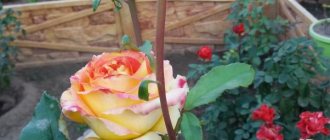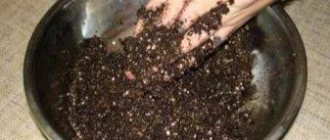Features of Dutch roses
This group of colors includes completely different specimens, each of which is good in its own way. Breeders are trying and developing more and more new varieties, even more beautiful and original.
Dutch roses are grown for cutting
Advantages and disadvantages of Dutch roses:
| Advantages | Flaws |
| appearance; | do not tolerate transportation well; |
| bright, delicate aroma; | not the largest flower size compared to some other roses. |
| look great both individually and in bouquets; | |
| Ideal for wedding bouquets and special occasion decorations; | |
| uniqueness and diversity of species; | |
| unusual colors. |
So, how to plant seedlings?
- Loosen the soil;
- We bury the seedling just a little, be careful here, because if you overdo it, the plant will develop poorly;
- We have completed the previous stage, and move on to watering the roses, water until the roots are fixed in the ground;
- Fill the roses so that the grafting point is two centimeters above the ground (photo of the result);
And again, do everything with extra scrupulousness. Check the air readings, which in no case should exceed ten degrees Celsius, because errors can be disastrous. It happens that the temperature is above ten degrees, for the reason that not all greenhouses have the proper equipment. In this case, there is a way out - cover with film and wait until stem after stem grows, approximately the same size.
How to organize proper care?
The better the care is organized, the more successful the entire growing process will be.
In order to grow real beauties, organize drainage. But be sure to remember that the drainage system must be closed, so when you lay the pipes, pay attention to the laying depth (the interval between them should be no more than 5 meters, the depth is 1 meter). Flowers also love the sun, or rather its rays, to fall on the leaf part of the plant. And at the same time, he really doesn’t like it when the soil is illuminated. Therefore, you do not need to hesitate, do everything on time, and try to grow plants quickly. It happens that roses grow very intensively, the bushes are huge and then just thin it out.
It is also necessary to give strength to the Dutch rose in a timely manner. It’s done something like this: as soon as the first buds appear, we bend the very first bud. And subsequently, the plant becomes stronger, since all the strength is concentrated in the roots.
Technologies for growing roses are constantly improving, and therefore new methods, that is, all sorts of innovations, are appearing. And it is worth noting such improvements as drip irrigation, mineral wool, pumice, and so on. If you want to know how to organize year-round cultivation of this plant, then for your information there are roses in greenhouses in the video (video).
Application in landscape design
Landscape designers admire Dutch roses and actively use them to create original compositions. Conifers, such as blue spruce, look great between rose bushes. Moreover, the needles are useful for diluting the soil in which these flowers grow.
Continuously blooming roses - the most beautiful varieties
Roses are also often combined with small flowers in blue or purple. Popular wildflowers - cornflowers or bluebells - are perfect for such mixes.
Note! In Russia, these roses are almost never used to decorate urban and park areas, since they are not easy to care for. But they are often used to decorate the territories of country houses, mansions, and residences.
Dutch roses in landscape design
What is meant by a continuously blooming rose?
Experienced gardeners are well aware that there are repeat flowering plants. Depending on the type and variety, they are divided into two categories:
- blooming in waves;
- continuously blooming throughout the summer.
Pierre de Ronsard
Note! This variety is highly resistant to cold, and therefore tolerates frost in the Middle Zone and Siberia without any problems.
Can a rose bloom all summer?
Long-blooming roses in Russia feel great in forest-steppe, non-chernozem and steppe zones. In the middle zone, such plants will need shelter for the winter. If all the specifics of crop care are followed, nutrients are added in a timely manner, and weeds are removed, flower growers can enjoy the lush bloom of roses throughout the season.
The best varieties of Dutch varieties
Among all the roses from Holland, it is difficult to single out the most beautiful ones, since they are all magnificent in their own way. However, there are the most popular ones, already time-tested.
Grand Prix (Rose Grand Prix)
David Austin roses - the most popular varieties
Description of the flower:
- the Grand Prix variety belongs to the hybrid tea varieties;
- the height of the bush reaches 1.5 m, while the height of the stem is not lower than 70 cm, maybe about 120 cm;
- classic flower shape, diameter about 12 cm;
- burgundy petals;
- The aroma is delicate and lasts a long time.
For your information! This variety is grown primarily for sale due to not only its external characteristics, but also its high transportability. Also, the Grand Prix is able to maintain its commercial appearance for a long time.
Freedom
Variety characteristics:
- belongs to the hybrid tea group;
- the color is bright scarlet with a velvety tint;
- flower diameter can reach 15 cm;
- the bush grows up to 2 m in height, bushes well, the stem is long.
This variety tolerates cold well and prefers growing in shaded areas. Has an external resemblance to the Madame Red variety.
Hybrid tea variety Mohana
Description of the Mohana variety:
- compact bush, the height of which reaches no more than 60 cm;
- there are many dark green leaves, but few thorns on the stems;
- the petals are yellow, they have pointed edges of a reddish color;
- the buds are large and cone-shaped;
- pleasant, soft, persistent aroma.
Note! This variety is grown for cutting, as they are great for creating bouquets and flower arrangements. The main advantages of the variety are its unpretentiousness to weather conditions and good immunity to most common diseases.
High Magic
External characteristics of the flower:
- the color is a combination of yellow and red shades, they look like flames;
- the leaves are dark green, there are no thorns at all;
- height is slightly more than a meter;
- Only 1 flower appears on each shoot, and inflorescences are formed only occasionally.
For your information! Unlike most flowers in this group, this variety has virtually no scent.
The High Magic variety has almost no smell
Elite variety Vendela
This elite variety is also included in the hybrid tea group. Flowers are often used to make bridal bouquets due to their colors. They are cream, almost white, up to 1 m high.
Vendela variety
Lovely Lidia
Lovely Lydia is a variety belonging to a bush variety of spray roses, which appeared not so long ago, but is quickly gaining popularity. These are compact bush flowers, the height of which does not exceed 70 cm, the width of the bush is no more than half a meter. The flowers are small, maximum 4 cm in diameter. The color is bright pink or crimson. The core is darker than the main part of the flower. The flowering period is quite long. The conditions it requires are quite simple to comply with.
Lovely Lydia
Avalanche
Avalanche is a white hybrid tea rose with a light greenish tint. The buds are quite large and have a classic shape. The height reaches 1 m. The leaves are classic green.
Penny Lane
Penny Lane is a climbing Dutch rose. The flowers are cup-shaped and large in size. The color is initially creamy, becoming more pronounced a few days after the start of flowering.
Important! The variety is characterized by high immunity and resistance to frost.
El Toro
Brief description of El Toro:
- belongs to the hybrid tea group;
- the color is bright red, close to scarlet;
- bud diameter up to 12 cm;
- bush height is about 80 cm;
- There are a lot of bright green leaves on the stems.
This rose has high immunity to diseases and good tolerance to low temperatures.
Ilios
The Ilios variety has the following characteristics:
- semi-double cup type;
- minimum height 70 cm;
- green leaves with a glossy sheen;
- The color of the buds is bright yellow.
Ilios
Chiri
This variety is characterized by a beautiful burgundy-raspberry color. The bud opens up to 14 cm. The height of the bush reaches 70 cm. The leaves have a peculiar interesting coloring - dark green with burgundy pointed tips. This flower does not tolerate cold weather well.
The most famous varieties
It is very difficult to describe all varieties of roses, there are so many of them. Let's look at the most popular ones.
Grand Prix is one of the most popular varieties of hybrid tea roses with double burgundy flowers. The bushes are tall, lush, reaching 1.2 m. Flowers with a diameter of 10-12 cm have a classic shape, petals in buds of 30-40 pieces. It stays in a bouquet for at least 2 weeks without losing its attractiveness. Withstands cold temperatures down to -15⁰C.
The Grand Prix
- Luxurious Wendella is the owner of beautiful white and cream flowers, good for special occasions. It requires shelter even at -6⁰С.
- Bright red El Toro roses stand out with their double petals; there are up to 40 of them in each inflorescence. Grows up to 0.8 m, bud diameter 11 cm. Resistant to temperature changes.
- Miss Piggy has salmon-colored flowers, which lighten closer to the middle of the inflorescence. The flowers are lush - up to 40 petals, height up to 80 cm. The leaves are very decorative, the aroma is more subtle.
Miss Piggy
- Ilios - luscious lemon-yellow flowers impressively trimmed with a terry border. The bud is 11 cm, it has 30-35 petals, the rose grows up to 80 cm.
- Mojano roses also have cheerful yellow petals, but their tips are strewn with cherry specks. The compact bush is resistant to many negative factors: diseases, precipitation, cold.
- The Freedom rose has deep scarlet flowers that appear velvety, and the wavy edges of the petals add charm to the rose. Unlike its fellows, the plant prefers partial shade rather than sun.
Freedom
- The flowers of the Avalanche variety have an unusual color - greenish-white; they will decorate the bush until the cold weather. It is not affected by powdery mildew and tolerates transportation well.
- It is impossible not to note the border variety Lovely Lydia - it is literally strewn with bright pink flowers and just begs to be in the foreground of the garden plot.
- It’s rare that a rose can boast of the absence of thorns, but Dutch breeders managed to develop one - this is the Aqua variety with delicate petals colored pinkish-lilac.
This is interesting: Blue daisy: we explain thoroughly
How to grow Dutch roses: planting features
To grow Dutch roses, you can use one of two methods: purchasing a ready-made seedling from a flower shop or special nursery, or by cuttings. The first method is more successful, but at the same time more expensive. This way, the roses will quickly take root and delight the gardener with their gorgeous blooms.
Small garden roses - popular varieties
Planting cuttings may be a less productive and longer-lasting option, but it is also used quite often. Especially those who regularly breed and plant roses.
Important! Planting is carried out only in the spring, since over the summer the roses will have time to gain strength and adapt to the site, as well as prepare for the winter cold.
Features of agricultural technology in open ground
Dutch varieties are very sensitive to environmental conditions, and therefore it is quite difficult to grow them in an open area. However, for gardeners in the southern regions this task is quite feasible.
Soil and location requirements
Since plants love warmth very much, and the roots do not tolerate hypothermia, it is best to plant them in a well-lit place. In this case, the rose garden should be protected from wind and drafts, and also be located away from garden trees.
The capricious beauty grows well in almost any soil. The main thing is that the soil is nutritious, moisture-absorbing, and well-drained. However, according to experienced gardeners, the following substrate is ideal:
- 2 hours of garden soil;
- 1 tsp peat;
- ½ tsp compost.
Landing rules
Dutch roses are planted in open areas in the spring, when warm weather sets in. Prepare the landing site in advance. To do this, dig up the area well, adding mineral fertilizers. The holes are made according to the size of the root system, and 1 tbsp is poured onto the bottom. compost and wood ash.
Before planting seedlings, they are treated with a weak solution of manganese. This procedure reduces the risk of fungal diseases of the rhizome. Next, the young plants are placed in the planting holes, leaving the grafting point two fingers above the surface. The free volume is filled with a nutritious soil mixture, and in order for the bush to be firmly fixed, the trunk circle is abundantly moistened.
High-quality planting material can be purchased at a gardening nursery
Flower care
Growing Dutch roses in an open area requires appropriate care. It consists of the following:
- Regular, abundant watering with soft, settled water at room temperature. The procedure is carried out in the morning or evening exclusively at the root, so as not to wet the greens or buds.
- Compliance with the feeding schedule. During the active growing season, plants must be fed in a timely manner, alternating mineral fertilizers with organic ones.
- Trimming. Produced in early spring, before the flow of juices, and in late autumn, after flowering. All damaged or dried parts of the flower are removed, and the crown is also formed to give the bush the desired shape.
- Prevention. To reduce the risk of infection and protect garden crops from parasites, roses are periodically treated with appropriate chemicals (fungicides, insecticides, acaricides).
- Shelter for the winter. Heat-loving hybrids will not survive until spring unless they are well covered. To do this, use sawdust, pine spruce branches or dense spunbond.
Care requirements
Since the variety of varieties of Dutch roses is very large, new ones are constantly appearing, it is difficult to provide a care regimen that will work for absolutely all varieties. But there are a number of general rules that should be followed.
Watering rules and humidity
Moistening the soil should be carried out regularly in the early morning or evening. Watering is done strictly at the root to prevent drops of moisture from reaching other parts of the plant. The water should be soft, well-settled at room temperature.
Fertilizing and soil quality
Almost any soil will do to grow Dutch roses. It must be nutritious, sufficiently loose, moisture- and breathable with good drainage. The most optimal substrate is considered to be one consisting of:
- garden land - 60%;
- peat - 25%;
- compost - 15%.
Feeding is carried out regularly from the beginning of the growing season. Fertilizers are applied once every 10 days. It is better to use ready-made complex solutions for roses. It is worth alternating mineral and organic fertilizers.
Note! During the flowering period, you should make sure that fertilizers do not contain nitrogen, which will promote the growth of green mass, but have a negative effect on buds and flowers.
Pruning and replanting
Pruning is done in early spring before the beginning of the growing season and in late autumn while preparing roses for winter. You should not carry out drastic pruning if it is not necessary. It is enough to simply remove old, dried, damaged branches. Using this procedure, the desired shape of the crown of the rose bush is formed.
Transplantation from place to place is carried out only in the spring, if necessary. The bush is carefully dug up and pulled out along with the earthen lump so as not to damage the delicate roots. After this, it is carefully transferred to the prepared planting hole to the place where it will now grow.
Features of wintering Dutch varieties
The best wintering option for Dutch rose varieties is a greenhouse. If it is possible to put them in a greenhouse for the winter, you should definitely do so. If this is not possible, then covering with a special material is required to protect the roses from winter frosts (there are different options for every taste and budget) and natural insulation - spruce branches or leaves. If a florist uses other methods on his farm, they will also be suitable, the main thing is the result. Roses need to be warm in winter.
Sheltering roses for the winter
Growing roses in greenhouses
The capricious beauty feels much better in greenhouse conditions. If the greenhouse is heated, flowers can be grown all year round.
Requirements for greenhouses
It is almost impossible to achieve abundant flowering by simply covering the plants with film. In order for the seedlings to take root well, actively develop and produce large buds, the greenhouse must meet certain parameters:
- spacious room with high ceilings;
- drip irrigation;
- air temperature regulator and controller;
- constant humidity at the right level;
- high-quality fertilizers;
- good ventilation;
- sufficient lighting.
The flower feels comfortable in greenhouse conditions
Recommendations for planting
Planting Dutch roses in greenhouses differs little from the method for open ground. The soil is prepared in advance by digging it up and adding fertilizers. Next, planting holes are made about 60 cm deep, into which a little organic matter is poured. Having installed the plant in the hole, dig it in with soil and then moisten it abundantly.
Before planting, it is recommended to soak the roots of the seedling for a day in warm water so that they are saturated with moisture. Author's advice
Subtleties of care
In order for young animals to quickly adapt and begin to actively develop, it is necessary to strictly follow the rules of agricultural technology for greenhouses:
- for the first 10 days the air temperature is kept at +6 °C;
- every next week and a half they raise the indicator by a couple of degrees, stopping at +12 °C;
- increase watering volumes;
- after 20 days, when the buds appear, the temperature is increased to +22 °C;
- as soon as the inflorescences begin to acquire color, the indicators are reduced to +18 °C.
Maintaining temperature conditions helps protect roses from premature opening and extends the overall flowering period.
Propagation of Dutch roses
Dutch roses are propagated exclusively by cuttings. Instructions for the procedure:
- Choose the right cuttings. It must have at least 3 buds. It is cut from the top side at an acute angle, from the bottom - evenly.
- The leaves on it need to be cut in half, and the lowest one should be cut off completely.
- It is best to plant cuttings in a greenhouse. There they are immediately planted in open ground, periodically moistening the soil.
- If the propagation procedure is carried out at home, you must first place the cuttings in a root growth accelerator solution in a warm, bright place. Additional lighting will increase the speed of root formation.
- In a month and a half, thickenings will become visible on the cuttings - the rudiments of the root system. This is a sign that you can plant them in separate pots.
- The seedling can be moved into open ground after another couple of months. The hole in which it will be placed initially should be filled with a mixture of earth, sand and humus (2:1:1).
Note! Growing a new plant from flowers presented in a bouquet will be quite problematic, since they are treated with chemicals and have practically lost the ability to germinate.
Planting and care
An extremely important factor for the successful breeding of roses is a suitable location. It is with his choice that one should begin.
These flowers, like no other, are particularly sensitive to heat. Their root system is poorly adapted to cold conditions. Therefore, the chosen location should be well illuminated by the sun and also provide protection from strong draft winds.
Most Dutch roses love slightly acidic, nutritious soils. which allow air to pass easily.
Growing in greenhouses is the best option. because they guarantee conditions that are most suitable for these plants. But, depending on the variety and region of the country, Dutch ones can grow well in open ground.
Before planting, you need to properly prepare the soil: use drainage and apply fertilizer.
Growing in greenhouses is the best option, since they guarantee conditions that are most suitable for these plants
The two most common ways to grow Dutch varieties are to either buy ready-to-plant seedlings or root cuttings. Seedlings are known for their high cost, but will require slightly less labor.
Cuttings are carried out in the following sequence:
- from the middle part of the shoot with two or three buds, twigs measuring 13-15 cm are cut;
- An oblique cut is made from below at a distance of 1 cm from the kidney, from above the cut should be straight with an indentation of 0.5 cm above the upper kidney;
- the lower leaves are completely removed, the upper ones are shortened by about a third, the thorns are also removed;
- the upper sections are treated with a solution of brilliant green, the lower edges of the cuttings are placed in a root former solution and kept there for 12 to 24 hours.
Prepared cuttings are deepened into the soil by 2-3 cm
It is important that the lower bud is deepened into the substrate, and the upper one remains on the surface. The cuttings are watered and covered with a plastic bottle, having previously cut off its neck
As an alternative to commercially available root growth preparations, you can use willow infusion.
To prepare it, you need to cut five to six 1-2-year-old shoots into pieces of 3-5 cm. Place them in a saucepan or glass and fill with hot water to half their height. Let it brew for a day.
This solution can be used to water plantings of young roses. There is no need to dilute it.
After about 3-4 weeks, the first strong leaves will appear, after which the bottle is removed. The cuttings should be sprayed several times a day every day. After rooting, the seedlings are planted in a permanent place.
The two most common ways to grow Dutch varieties are to either buy ready-to-plant seedlings or root cuttings
In a similar way, you can try to grow a garden queen from a gifted or purchased bouquet. But it should be borne in mind that imported flowers are usually treated with preservatives to ensure the plants look fresh.
This chemical treatment significantly reduces rooting ability. Nevertheless, practice shows that even Dutch roses from a bouquet are capable of sprouting.
For successful rooting, the flowers from the bouquet must be fresh. The best option is to prepare cuttings on the same day that the bouquet was purchased or given as a gift.
If it is not possible to carry out cuttings immediately, then it is necessary to change the water in the vase daily so that the flowers do not rot. It is best to choose semi-lignified shoots. on which the formation of buds has just begun.
Pest and disease control
All varieties of Dutch roses have high immunity to diseases and pests. Most often, the problem arises either due to improper care (most often), or because neighboring plants are sick. This must be carefully monitored and, at the slightest sign of illness, treatment must be started using special means. Spring treatment with various preparations against pests and viral diseases and autumn digging of the soil around the flower, which will help cope with some insects, are also important.
If there are no problems, as a preventative measure you can use folk methods, such as treating the stems and leaves with a soap solution (from laundry, not cosmetic soap) or sprinkling the plant with mustard powder.
Dutch roses are one of the most beautiful and tall varieties of flowers. Every woman dreams of receiving a chic bouquet of these delightfully fragrant buds as a gift. You can grow them yourself in your summer cottage, delighting yourself, your family and neighbors with their amazing appearance and unusual bright colors.
Characteristics and features of flowers bred in Holland
Uninitiated flower lovers often think that Dutch roses are just such a variety.
In fact, the term Dutch roses means that certain varieties of these amazingly beautiful plants were bred by Dutch scientists.
They are grown both in the Netherlands itself and in many other European countries. The term Dutch roses is a kind of quality mark.
Holland has long established itself as a leader in the field of breeding technologies. It is in this country that the breeding of new, beautiful, resistant varieties has reached unprecedented heights. How do these flowers differ from all other varieties?
If we talk about external characteristics, then they are inherent. medium-sized bud (depending on the variety), delicate, graceful, elegantly shaped flowers, dense, rich foliage on the stem and a magnificent range of colors and shades.
In addition, cut Dutch roses, as a rule, are highly durable and can last in a vase, pleasing the eye for at least two weeks. It is the Dutch ones that we most often see in the windows of flower shops.
How to grow these exquisite beauties in your garden?
Cut Dutch roses are highly durable and can last in a vase for at least two weeks.











